#Savoy Records
Explore tagged Tumblr posts
Text
youtube
Since I Laid My Burdens Down - The Swan Silvertones (Since I Laid My Burdens Down, 1978)
#Soul#Soul Music#Soul Music Songs#Music#Music Songs#The Swan Silvertones#Since I Laid My Burdens Down#Gospel#Gospel Soul#1978#Savoy Records#Youtube
2 notes
·
View notes
Text

Werly Fairburn - Telephone Baby (1957) E. Myers from: "Telephone Baby" / "No Blues Tomorrow" (Single) "Werly Fairburn: Everybody's Rockin" (1993 Bear Family Records Compilation) "Rock-A-Billy Dynamite" (2013 Box Set | CD23)
Rockabilly
JukeHostUK (left click = play) (320kbps)
Personnel: Werly Fairburn: Vocals / Guitar Joe Martin: Bass Eddie Landers: Drums
Unknown: Piano
Recorded: @ The Cosimo Recording Studio in New Orleans, Louisiana USA August, 1957
Released: on September 9, 1957
Savoy Records
♫♫♫ ♫♫♫ ♫♫♫
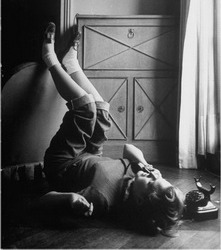
"Telephone baby, with your feet up on the wall" Photograph by Gordon Parks, 1951
Gordon Parks: https://en.wikipedia.org/wiki/Gordon_Parks
#Rockabilly#Werly Fairburn#1950's#Cosimo Recording Studio#Savoy Records#Popular Culture#E. Myers#Gordon Parks#Telephone Baby
5 notes
·
View notes
Photo
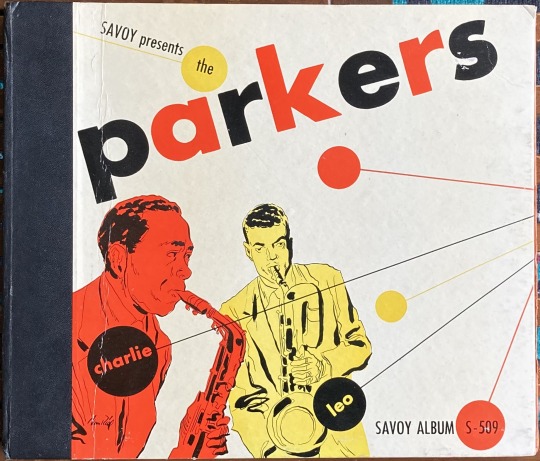

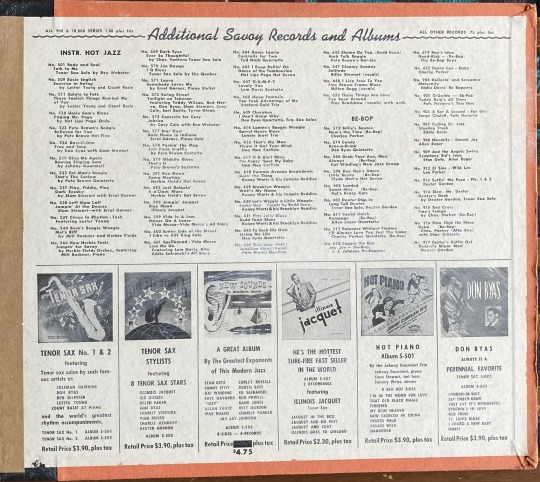
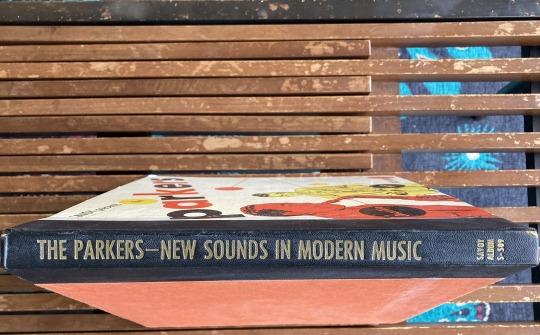






The Parkers - New Sounds in Modern Music, 1948 Savoy Records Album S-509
3 x shellac 10″ 78rpm records
youtube
#78rpm#be-bop#charlie parker#leo parker#miles davis#tadd dameron#max roach#howard mcgee#dexter gordon#j.j. johnson#duke jordan#savoy records#shellac
1 note
·
View note
Text
something about rick's last words to phin being him telling her to look away as he gets blown up
#had to rewatch the video recordings from the game for the fic im writing#This scene upsets me#The agony in Phin's voice AUGH#Jasmin Savoy you ate this role idc#peg speaks#spider man#insomniac spider man#phin mason#rick mason
5 notes
·
View notes
Text
Savoy Brown „Looking in” (1970) - their sixth album, I was looking for it fir a while and finaly found it for an affordable price✨
I really like their take on British blues rock, and would gladly add „Hellbound train” to my collection. One day I will 🤗


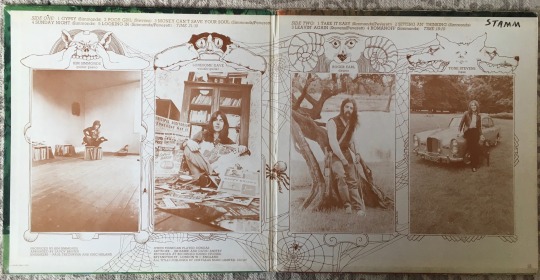

2 notes
·
View notes
Text
When I Was A Young Boy - Savoy Brown
Listen to more by this artist
4 notes
·
View notes
Text

5 notes
·
View notes
Text

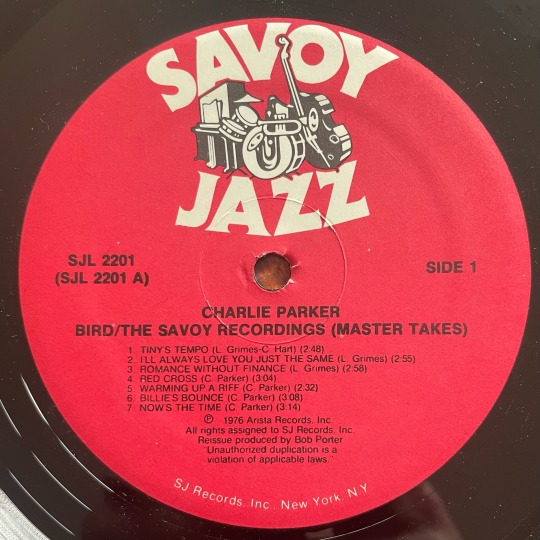



$1 at the library!
0 notes
Text

The first recorded pizza delivery dates back to 1889 when Queen Margherita of Savoy, tired of French cuisine, requested a local dish while visiting Naples. Renowned pizza maker Raffaele Esposito prepared three pizzas for the Queen, including one topped with tomatoes, mozzarella, and basil—symbolizing the red, white, and green of Italy’s flag. This pizza became famously known as the Margherita pizza in her honor.
618 notes
·
View notes
Text
Things in Lackadaisy that I haven’t seen anyone talk about (starting with fun facts and ending with more serious topics)
Rocky was an escape artist for a traveling circus when he was a teenager. This is why he was able to escape the train tracks at the beginning of the story.
Horatio likes to sing, but only when no one is around.
Freckle is the only character to have a middle name in his character bio (Allen). Do the other characters have middle names?
Nicodeme used to be (or possibly still is) a wrestler known as the “Cajun Gator”.
Rocky speaks at least some French; the Savoys speak a mix of English, Creole, and French; Mordecai speaks English, Hebrew, and some German; Nina speaks English and Irish Gaelic; Viktor speaks Slovak and English; Mrs. Bapka speaks Slovak and some English.
Serafine likes practical jokes. The only one we’ve seen her play is the “hatchetman” thing with Mordecai, where she told him to kill a man with a hatchet and he actually did it. Has she played other practical jokes on him?
Ivy’s classmates know that she’s friends with gangsters, because they ask if Rocky is one of her “gangster friends” when she sneaks him into their dorm building. Ivy seems to like the attention.
Nicodeme doesn’t know his exact birthday, and he and Serafine don’t know their exact relation to each other. They could be half-siblings or cousins, or maybe not related at all.
Rocky is very knowledgeable about myths and folklore, and he’s also very well read. Considering he didn’t finish his primary education, he must have either picked this up from his mother, the McMurrays, or he developed an interest later in his life.
Rocky has frightened elderly people before, though he got along well with Mrs. Bapka.
Ivy’s father, Reuben Pepper, wasn’t just friends with Atlas— he owned a train station and helped him smuggle alcohol into the city. He must not do business with the Lackadaisy anymore, either because of Atlas’s death or for another reason. He was business partners with Atlas, but not Mitzi.
The name of Mordecai’s late baby sister, Hannah, is the combination to the safe he writes about in “Posthaste”.
Rocky doesn’t drink due to “past experience”. Did he drink before and then quit, or he see someone else drink and decide never to do it?
Mordecai shows a lot of the signs of autism. He comes across as very cold and unemotional, even with his own family members and closest friend. He doesn’t seem to feel empathy for people he doesn’t care about (often, autistic people will either feel far more empathy than is considered appropriate, or not nearly enough of it to be considered appropriate.) He has difficulty with social relationships and interaction, whether it’s casual flirting, working with others, negotiating with his boss, or developing and maintaining personal friendships. He is physically sensitive and can barely tolerate physical touch, crowded environments, or getting dirty or wet. He is very particular about the way he eats and dresses, to the point where other people point it out. He has an intense and unusual interest in geometry that confuses other people when he talks about it, but it seems to bring him comfort and excitement. (For the record, Rocky is the only one who rolls with it and asks him to tell him more.)
Both Elsa and Viktor have trauma from the war and show signs of PTSD. Viktor also used to stay at the Arbogast house to help keep them safe. When Ivy and Rocky arrive at her house, Elsa asks about Viktor and talks about him later on. This probably means that they were friends.
Corporal punishment was the standard for raising children in the early 20th century, especially in Ireland. Nina slaps Rocky and pushes him down the stairs in two different scenes. Rocky even mentions Nina caning (beating someone with a walking cane) him if he got mud on Freckle’s clothes— which might have been a joke, but it had to come from some truth. Rocky was shown to get into all kinds of trouble as a child, though we don’t see the consequences for it. At the time, “physical punishments” were considered normal, but there is now extensive, undeniable research that shows what kind of psychological damage it causes later in the child’s life. You’ve read the comic, and you know that Rocky is not mentally healthy.
#lackadaisy#rocky rickaby#lackadaisy cats#lackadaisy rocky#mordecai heller#autistic mordecai heller#freckle lackadaisy#calvin mcmurray#ivy pepper#horatio bruno#Lackadaisy horatio#lackadaisy nico#nicodeme savoy#serafine savoy#lackadaisy serafine#mrs bapka#viktor vasko#sedgewick sable#elsa arbogast#lackadaisy elsa#lackadaisy nina#nina mcmurray#autism headcanon#cw child abuse#cw alcohol#cw smoking#cw child death
119 notes
·
View notes
Note
He was at Three Sheets yesterday night with Ashley. Check their respective stories
Dear Three Sheets Anon,
Your information is correct. What I meant by 'nothing to do with Ashley Hearn' in my post is a bit different, though. Ashley has been in London for a while already, obviously for sales & marketing purposes. She clearly posted about it and even suggested she will be in Scotland soon. But she is not the reason he is in London these days. She already successfully toured several bar outlets by herself, using her own business contacts, in New York and elsewhere: meeting her boss while in London is absolutely normal and nothing to write home about. But not the main reason he is in London right now, I think.
So it would seem they met at the Three Sheets Bar, yesterday.
S's IG story:

[Later edit]: Ashley's IG story - too bad I interrupted myself to get a delivery and then lost this thread:

S tagged both the bar and SS's IG accounts. This is a routine business meeting, especially considering the Three Sheets also deals in business consulting:

They have two outlets in London, one in Dalston and the other in Soho. Both have excellent reviews and well, the expected price range for cocktails in London (10-20 £ ):


Your ask also gives me the opportunity to come forward with several things I have been keeping in my drawers for a while, so thank you for that. Kind of.
Remember (LOOOL and then some more for that, always) my through the grapevine info that C joined S and the team at Milady's bar in New York, on October 17 2024, after the Versace Armani event she attended with Maria McManus? I also remember the Without Pix Anon:

Well, I don't have 'pix' , but I do have the next best thing (gracias a ti, siempre ❤️):

Ashley liked what C posted on October 25, 2024. One full week after the Milady's get together - why would she, if C wasn't there at all, like all the Righteous Pundits lie to you?

She also briefly followed her on IG, but not anymore (why? I will let you draw your own conclusions), along with several OL cast members (followed all of them at the same moment, after the event): Rankin, John Bell and Skeleton. Bell and Skeleton were at that get together, too (unsure about Rankin? it's Saturday, after all and I am not the Metropolitan Police, either - please correct me if I am wrong). She still follows them on IG. Clearly they met there?
The second thing I wanted to bring along is Maximum Wobbler Bullshit's recent nonsense:

This impostor and mythomaniac I have repeatedly debunked in the past still has very scant English, negligent writing skills at best and no damn idea about what marketing means. She was completely triggered by this particular post, on November 5, 2024 (while almost everyone was looking elsewhere, for obvious reasons):

Featured in the pic is Mia Kumari, a good friend of Ashley Hearn. Maximum Wobbler Bullshit conveniently forgets to explain who Mia Kumari is:

Based in London, UK and currently mixing at the Satan's Whiskers bar in Bethnal Green (after a short spell at The Savoy, hello?), she is a well-known, up-and-coming bartender with a consistent record of awards:

The press is raving about her:


[Full article, here: https://foodism.co.uk/features/long-reads/women-london-bar-scene/]
She is also a feminist bartender, with an internationally praised agenda:

[Mia was last week in Greece, as guest speaker at the very prestigious Athens' Bar Week. Too bad I left: I would have certainly bought a ticket and gladly listened to what she had to say - https://www.athensbarshow.gr/guest-speakers/mia-kumari]
Surely a trailblazer 'in London’s dynamic and globally revered bar industry', who also is 'an advocate for equality, diversity and inclusion' does not need Sassenach Spirits to promote herself. She is doing a smashing job at it, like the pro she clearly is: on trend, progressive, sought after and more than noticed. I fail to see where the fuck the alleged cronyism is, because that would simply mean Mia Kumari is a social zero, a nobody in the UK's spirits industry, taking advantage of her friendship with Ashley Hearn in order to get more attention for her sole benefit. That is a lie and that is simply wrong: if anything, it is Sassenach Spirits that needed to prominently feature someone like Mia Kumari, in order to align itself to the values she is so actively promoting (all values C is sensitive to, hmmm). We are miles away, here, from the Cutty Sark wannabe (in)famous Labour Day boat party in Marina del Rey, featuring the BBC/Blue Bikini Chick, back in September 2023 (https://www.tumblr.com/sgiandubh/727347023165145088/its-all-fake-anyway), when all the fandom trolls were on fire. So, Sassenach Spirits needed to do exactly something along these lines, in order to promote and boost the seasonal Xmas sales of their tartan scarves, SS's most expensive merch, targeting a younger, more sophisticated urban crowd.
Clever brands constantly redefine themselves, looking for the right trends and the right crowds to promote their products to. This is a clear sign that finally adults are in the room, now, at SS's Marketing and Sales respective departments. So damn glad to see this welcome shift!

101 notes
·
View notes
Text
youtube
What Would You Give - The Artistic Sounds (Message To A Nation, 1977)
#Soul#Soul Music#Soul Music Songs#Music#Music Songs#The Artistic Sounds#1977#Gospel#Gospel Soul#Savoy Records#What Would You Give#Youtube
5 notes
·
View notes
Text

Savoy Brown - Hellbound Train (1972) Kim Simmonds / Andy Silvester from: “Hellbound Train” (LP)
Blues | Blues/Rock | British Blues | Dirge
JukeHostUK (left click = play) (320kbps)
Album Personnel: Dave Walker: Lead Vocals Kim Simmonds: Lead Guitar / Harmonica / Backing Vocals Paul Raymond: Keyboards / Guitar / Backing Vocals Andy Silvester: Bass Dave Bidwell: Drums
Produced by Neil Slaven
Recorded: @ The Trident Studios in London, England UK 1972
Released: in February, 1972
Deram Records (UK) Parrot Records (US)
#Savoy Brown#Hellbound Train#Kim Simmonds#1970's#British Blues#Blues/Rock#Deram Records#Parrot Records#Andy Silvester#Dirge
2 notes
·
View notes
Note
I'd love to see Kate and Anthony make a return trip to the Savoy for anniversary celebrations!
Imagine Anthony calling trying to book for Kate’s birthday and insisting on the exact same room.
“I stayed with you a few years ago with a beautiful woman. I need that exact room.”
“I can… certainly search for the records, lord Bridgerton.”
“That would be very helpful, Thank you. I’m fairly sure that room is the reason we’re together now.”
The clerk paused. “It has… been renovated since then.”
Anthony paused, “Well… even so.”
He’s enlisted Edwina to look after Neddy for the night, promising their son that he can come and have fancy breakfast with them at the restaurant in the morning and that he can have chicken nuggets and chocolate milk for dinner if he wants. He’s booked appointments for Kate at the Spa and has reservations for dinner that he’s half hoping turns into room service in bed. He has it all planned when he picks Kate up from work.
And his stomach drops as he waves at the receptionist who’s familiar with him now and makes his way down the hall to Kate’s office. Everyone else has cleared out being a Friday afternoon and there’s his girlfriend, tucking the shirt he knows she’d been wearing when she left the house this morning into her bag.
She’d looked like this that night as well, her blazer buttoned over her bare skin after someone drunk had spilled a drink on her white shirt. He’d hardly been able to breathe then when he’d looked at her then either. Definitely not now when she winks at him through the glass walls.
“I’m pretty sure that’s not workplace appropriate.”
Kate rolled her eyes before she leaned in and kissed him, “Good thing I’m only recreating things for you.”
“Looks like I’m a lucky boy. If I remember correctly you had a very nice garter belt under that skirt.”
“It might be there again.”
It felt almost the same, his arm around Kate’s waist when they arrived at the hotel, clearing his throat as he smiled at the clerk
“My wife and I have a room booked. Bridgerton?”
“You need to stop calling me your wife.” Kate chuckled as they stepped into the lift. “Buy me a ring if you want to call me that.”
“Have I not asked you to marry me yet? Doesn’t sound like me.”
“You haven’t actually.”
“Jesus, what are you doing with me?”
“You’ve got some good attributes.” Kate smiled against his neck, “We made a very cute kid as well. We should probably have more for the sake of the human race.”
“Very valid.“ He fiddled with the door they’d stopped in front of before he threw it open. “Wanna practice conceiving another one in this room? I think I remember the positions.”
“Go on then.”
#surprise neddy au#kathony#anthony x kate#kate sharma#kate sheffield#anthony bridgerton#molly’s asks and answers
84 notes
·
View notes
Text

"The most notable players in Palaiologue politics were the empresses Yolanda-Irene of Montferrat and Anna of Savoy, and on the whole their record is woeful: Yolanda-Irene of Montferrat, second wife of Andronikos II, was unable to comprehend the succession rights of her eldest stepson, Michael IX, and since her husband remained obstinately unmoved by her representations she flounced off with her three sons to Thessalonika where she kept a separate court for many years from 1303 to her death in 1317. From her own domain she issued her own decrees, conducted her own foreign policy and plotted against her husband with the Serbs and Catalans: in mitigation, she had seen her five-year-old daughter married off to the middle-aged Serbian lecher Milutin, and considered that her eldest son John had been married beneath him to a Byzantine aristocrat, Irene Choumnaina. She died embittered and extremely wealthy.
When Yolanda’s grandson Andronikos III died early, leaving a nine-year old son John V and no arrangements for a regent, the empress Anna of Savoy assumed the regency. In so doing she provoked a civil war with her husband’s best friend John Kantakouzenos, and devastated the empire financially, bringing it to bankruptcy and pawning the crown jewels to Venice, as well as employing Turkish mercenaries and, it appears, offering to have her son convert to the church of Rome. Gregoras specifically blames her for the civil war, though he admits that she should not be criticised too heavily since she was a woman and a foreigner. Her mismanagement was not compensated for by her later negotiations in 1351 between John VI Kantakouzenos and her son in Thessalonika, who was planning a rebellion with the help of Stephen Dushan of Serbia. In 1351 Anna too settled in Thessalonika and reigned over it as her own portion of the empire until her death in c. 1365, even minting her own coinage.
These women were powerful and domineering ladies par excellence, but with the proviso that their political influence was virtually minimal. Despite their outspokenness and love of dominion they were not successful politicians: Anna of Savoy, the only one in whose hands government was placed, was compared to a weaver’s shuttle that ripped the purple cloth of empire. But there were of course exceptions. Civil wars ensured that not all empresses were foreigners and more than one woman of Byzantine descent reached the throne and was given quasi-imperial functions by her husband.
Theodora Doukaina Komnene Palaiologina, wife of Michael VIII, herself had imperial connections as the great-niece of John III Vatatzes, and issued acts concerning disputes over monastic properties during her husband’s reign, even addressing the emperor’s officials on occasion and confirming her husband’s decisions. Nevertheless, unlike other women of Michael’s family who went into exile over the issue, she was forced to support her husband’s policy of church union with Rome, a stance which she seems to have spent the rest of her life regretting. She was also humiliated when he wished to divorce her to marry Constance-Anna of Hohenstaufen, the widow of John III Vatatzes.
Another supportive empress consort can be seen in Irene Kantakouzene Asenina, whose martial spirit came to the fore during the civil war against Anna of Savoy and the Palaiologue ‘faction’. Irene in 1342 was put in charge of Didymoteichos by her husband John VI Kantakouzenos; she also organised the defence of Constantinople against the Genoese in April 1348 and against John Palaiologos in March 1353, being one of the very few Byzantine empresses who took command in military affairs. But like Theodora, Irene seems to have conformed to her husband’s wishes in matters of policy and agreed with his decisions concerning the exclusion of their sons from the succession and their eventual abdication in 1354.
Irene and her daughter Helena Kantakouzene, wife of John V Palaiologos, were both torn by conflicting loyalties between different family members, and Helena in particular was forced to mediate between her ineffectual husband and the ambitions of her son and grandson. She is supposed to have organised the escape of her husband and two younger sons from prison in 1379 and was promptly taken hostage with her father and two sisters by her eldest son Andronikos IV and imprisoned until 1381; her release was celebrated with popular rejoicing in the capital. According to Demetrios Kydones she was involved in political life under both her husband and son, Manuel II, but her main role was in mediating between the different members of her family.
In a final success story, the last Byzantine emperor, Constantine XI, owed his throne to his mother. The Serbian princess Helena Dragash, wife of Manuel II Palaiologos, in the last legitimating political manoeuvre by a Byzantine empress, successfully managed to keep the throne for her son Constantine and fend off the claims of his brother Demetrios. She arranged for Constantine’s proclamation as emperor in the Peloponnese and asserted her right to act as regent until his arrival in the capital from Mistra in 1449.
Despite the general lack of opportunity for them to play a role in politics, Palaiologue imperial women in the thirteenth century found outlets for their independent spirit and considerable financial resources in other ways. They were noted for their foundation or restoration of monastic establishments and for their patronage of the arts. Theodora Palaiologina restored the foundation of Constantine Lips as a convent for fifty nuns, with a small hospital for laywomen attached, as well as refounding a smaller convent of Sts Kosmas and Damian. She was also an active patron of the arts, commissioning the production of manuscripts like Theodora Raoulaina, her husband’s niece. Her typikon displays the pride she felt in her family and position, an attitude typically found amongst aristocratic women.
Clearly, like empresses prior to 1204, she had considerable wealth in her own hands both as empress and dowager. She had been granted the island of Kos as her private property by Michael, while she had also inherited land from her family and been given properties by her son Andronikos. Other women of the family also display the power of conspicuous spending: Theodora Raoulaina used her money to refound St Andrew of Crete as a convent where she pursued her scholarly interests.
Theodora Palaiologina Angelina Kantakouzene, John Kantakouzenos’s mother, was arguably the richest woman of the period and financed Andronikos III’s bid for power in the civil war against his grandfather. Irene Choumnaina Palaiologina, in name at least an empress, who had been married to Andronikos II’s son John and widowed at sixteen, used her immense wealth, against the wishes of her parents, to rebuild the convent of Philanthropes Soter, where she championed the cause of ‘orthodoxy’ against Gregory Palamas and his hesychast followers. Helena Kantakouzene, too, wife of John V, was a patron of the arts. She had been classically educated and was the benefactor of scholars, notably of Demetrios Kydones who dedicated to her a translation of one of the works of St Augustine.
The woman who actually holds power in this period, Anna of Savoy, does her sex little credit: like Yolanda she appears to have been both headstrong and greedy, and, still worse, incompetent. In contrast, empresses such as Irene Kantakouzene Asenina reflect the abilities of their predecessors: they were educated to be managers, possessed of great resources, patrons of art and monastic foundations, and, given the right circumstances, capable of significant political involvement in religious controversies and the running of the empire. Unfortunately they generally had to show their competence in opposition to official state positions. While they may have wished to emulate earlier regent empresses, they were not given the chance: the women who, proud of their class and family, played a public and influential part in the running of the empire belonged to an earlier age."
Byzantine Empresses: Women and Power in Byzantium AD 527-1204, Lynda Garland
#history#women in history#historyedit#queens#empresses#byzantine empire#byzantine history#medieval women#13th century#14th century#15th century#historyblr#historical figures#byzantine empresses#irene of montferrat#anna of savoy#helena dragas#Theodora Doukaina Komnene Palaiologina#Irene Kantakouzene Asenina#Helena Kantakouzene
64 notes
·
View notes
Text
It’s Kim Simmonds farewell. I’ve just learned he’s gone 🥺
I saw Savoy Brown live about 10 years ago, Kim was the only original member left. The show was very energetic and enjoyable. It was a small pub and Kim went out after the concert to sign some records and chat with fans. That’s how I’ll remember him - as a great musician and a great, amiable guy 😥
Spinning some Savoy Brown classics tonight.

3 notes
·
View notes